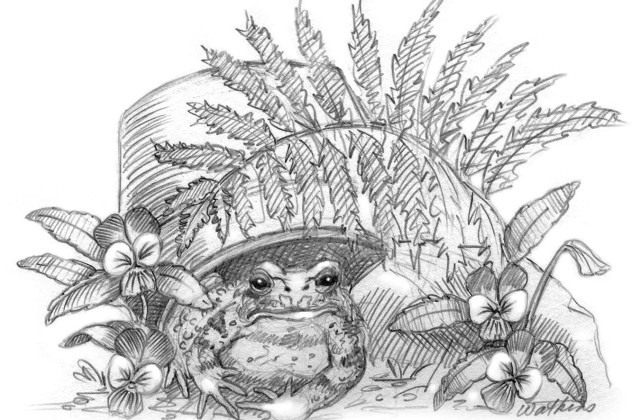Through The Garden Gate
July—The Bugs Have Arrived!
By Leslie Watkins
Gardens are looking lush and beautiful and attracting plenty of admiring glances from garden tour groups and now, pests. Cabbage white butterflies, tomato hornworms, red lily leaf beetles, Japanese beetles, slugs and snails to name a few. Hand picking, applying nontoxic pesticides, and setting baits are all useful strategies, but we have natural allies, too. Beneficial insects, birds, and other small animals are great ways to keep up the defenses while you are busy doing other things, like sleeping. Providing habitat for helpful critters and growing host plants to feed them will encourage their presence.
Cabbage white butterflies are pollinators, and lay their eggs on plants in the brassica family. The larvae can turn your kale and cabbage leaves into lace. Inspect the underside of leaves frequently for the cocoons and little green caterpillars and squish them. Predators include birds, ants and mantids. Spraying with BT (what is BT?) is very effective, but it only works during the caterpillar stage.
Tomato hornworms make delectable treats for chickens. The happy recipient will run around in circles squeaking with joy while the rest of the flock makes chase. This is hilarious and cheap entertainment on the farm. If no chickens are available, simply dispatch the culprit with your heel. If, however, the hornworm is neatly studded with what appears to be upturned grains of fuzzy rice, allow it to die peacefully in your garden. Those “grains of rice” are the cocoons of the parasitoid braconid wasp, and if left to develop on the hornworm they will live to make more hornworm killing wasps.
Red lily leaf beetles are found on asparagus, ornamental lilies and Fritillaria species. They will scurry to hide on the opposite side of the stem when they see you coming. If you try to catch them, they will drop to the ground and flip upside down to show their dark undersides and become invisible. One solution is to hold a can of water with a little oil in it, under the beetle so it falls directly into the can. It may be helpful to drape a light colored cloth under the plant to see them before they burrow under the soil. People who are really ticked off by their wide scale defoliation won’t mind squishing them with bare hands. Neem will repel the beetles and must be applied every five to seven days.
Japanese beetles traditionally arrive on July 4 and can be hand-picked into cans of soapy or oily water. A trap planting of grapes on a wobbly arbor over the chicken yard will attract many beetles. A sharp shake dislodges the bugs to the eagerly awaiting chickens below who gobble them up like popcorn. If your lawn is spotted with signs of night digging, it may be your friend the striped skunk searching for Japanese Beetle grubs. Once your lawn is cleared, the skunk will move on to your neighbor’s. Moles are another eater of these grubs, and skunks also eat the moles and mice.
Slugs and snails are favored by toads, snakes and centipedes. Providing habitat for beneficial creatures in damp spots in your garden furnished with rotting logs and leaf litter will encourage them to stick around (pun intended.) Toad houses may be made from upturned clay flower pots propped up with small stones, to provide relief from the sun. Toads are territorial, and can be tamed. In captivity they may live for up to thirty years. Toads are a gardener’s best friend. They eat cutworms, wireworms, caterpillars, flies, slugs and snails. A single toad can consume up to 10,000 bugs over a three month season.
June through July is when we have our greatest honey flow. The honey bees are busy collecting from white clover (their tongues can’t reach red clover nectar), alfalfa if left uncut, milkweed, vetch, sumac, mint, and American linden trees. July is the ideal time to sow buckwheat in our region. It helps to provide the bees with nectar during dearth times, such as before the golden rod and asters flower. At just six weeks from seed to flower, buckwheat provides nectar for the bees, which makes great honey. It also makes a great “green manure” crop to sow in your fallow garden beds. Bees need plenty of water to drink and to cool the hive. Trays of pebbles kept covered with water will also help quench the thirsts of birds and butterflies.
Vegetables to plant in July for fall harvest include beets, turnips, spinach, Swiss chard, radishes, lettuce, mesclun greens and kale.
July Chore Checklist:
Raise the blade on your lawnmower.
Check for tomato hornworms and cabbage worms.
Propagate roses and buddleia from cuttings.
Keep pulling weeds before they can reseed.
Water as needed, especially newly planted trees and shrubs.
Pick cucumbers and summer squash while they’re young.
Sow fall harvest crops; kale, cabbage, beets.
Deadhead and cut back flowers to encourage re-bloom.
Harvest and enjoy garlic scapes.
Continue harvesting micro-greens and lettuce.
Drawing by Leslie Watkins.

